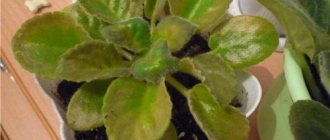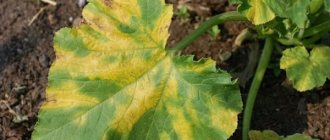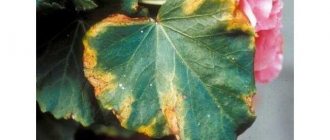If you properly care for the plant, it will grow actively and often delight you with its flowers. How to treat violet diseases and provide the plant with proper care?
How to properly care for a plant? Experienced flower growers believe that for violet to actively grow and maintain it comfortably, it is necessary to get closer to the climate of its homeland. Considering that violets began to spread to the world from Africa, where it is always warm and humid, then it is natural that with dry air, lack of light or low temperature, the flower begins to wither and ache.
During this period, her resistance to bacteria, fungus, and microorganisms becomes worse. The optimal conditions for growing a flower will be a temperature range from 20 to 25 degrees. This room temperature should be constant.
Fears of violets
Violet has a negative attitude towards drafts and any temperature changes. If you put a violet in a cold room, it stops growing. And if you water it heavily, the root system and leaves begin to rot. When the room is too hot and the temperature is above 30 degrees, this increases the likelihood of contracting a bacterial infection.
A lot depends on the substrate that is poured into the growing pot. It is through the soil that insects and various infections most often enter.
The soil in the container should be light so that excess water drains away and the roots do not rot. Due to its fragile roots, violets are prone to root rot, so it is better to freeze the soil for several days before planting.
The substrate should not be wet, and violets also react negatively to watering with cold water. To achieve light humidity, you can place a tray with wet pebbles or moss on the windowsill. If the soil is acidic, yellow spots appear on the leaves and the rosette thickens.
Treatment options
Most diseases of violets are incurable , and therefore little helps in the fight against them. Infected flowers are removed from other plants and destroyed along with the soil lump.
However, if there is hope of saving at least one specimen, then fungicides will come to the rescue.
The drugs are aimed at destroying fungal spores and counteracting infections. In addition to proper processing, violets need to change their maintenance conditions:
- reducing humidity levels by reducing watering of flowers;
- placing violets in a warm and well-lit place;
- removing the top layer of soil in which fungal spores can live.
The most spectacular varieties of violets: “Dance of Galaxies”, “Duchess”, “Wind Rose”, “Ice Rose” and “Royal Lace”.
The most common diseases of violets
All diseases of indoor violets are divided into infectious and non-infectious. Since the flower is quite sensitive to damage, it is better to prevent violet diseases than to treat them for a long time. If affected by fungus or bacteria, violets are removed from the windowsill and the room from other flowers so as not to infect them. Quarantine is also mandatory for insect infestations.
If parasites are found in at least one pot, it is recommended to completely treat all plants as a preventive measure. If the disease is non-infectious, then sometimes it is enough to change the rules of care or enrich the substrate with scarce substances. Below you can read about violet diseases with photographs and their elimination.
Non-infectious pathologies
The flower is very sensitive if it is planted in unfertilized soil or, conversely, it is constantly fed. With nitrogen deficiency, the leaves become pale and the violet begins to bloom worse. If you overfeed plants with nitrogen fertilizers, the stems lose their strength, the buds develop poorly and are quickly affected by fusarium.
Popular: Types of aphids and methods of getting rid of houseplants
When leaves become chlorotic, they become faded or acquire a yellow-green tint. The leaf veins remain green. Usually, chlorosis affects not the entire flower, but part of it. This disease can be caused by magnesium deficiency or too much potassium in the soil. Fertilizer with magnesium sulfate is suitable as a preventive measure.
If the violet grows small leaves, the greenery of which fades, and the cuttings stretch out, then the violet probably does not have enough sunlight. In this case, the petioles begin to stretch, and the leaf blade bends. To stop this, just put the plant in a brighter place.
If there is a deficiency of potassium, phosphorus or calcium in the substrate, the upper leaves begin to wither, and the growth of the entire flower gradually deteriorates. Another reason for this condition may be a sharp change in temperature.
The plant stops blooming completely if the soil is too acidic or if it is salted. A characteristic feature of this condition is that the violet leaves curl.
If watering is improper, light spots appear on the upper leaves. This is due to moisturizing the flower with cold water or sunburn. Water the plant with water at room temperature or warm. If the air in the room is humid and there is little light for the violet, then the leaves may be affected by a white coating. This is powdery mildew. Spraying with foundationazole will help.
Common problems
Why have violets become small and dull?
If a flower lacks natural light, then new generations of leaves, compared to old ones, grow smaller and look duller. Their petioles lengthen, the edges of the leaf blades bend upward. You should move the flower pot to a windowsill illuminated by diffuse sunlight. In the autumn-winter period, additional artificial lighting for up to 12 - 14 hours will not hurt. Just protect it from direct sunlight and drafts. You will see that the violet will soon recover and return to normal.
Why do violet leaves rise up?
Ideally, violet leaves are positioned horizontally relative to the stem. True, some varieties of violets, for example, King's Ransom, Neptune's Jewels, Happy Feet, are predisposed to some lifting of the leaves upward. If you have a violet of a different variety, and its leaves suddenly begin to rise and curl, there may be several reasons:
- Incorrect lighting. It should not be weak or excessive. On a southern sunny windowsill there must be a light cover in the form of curtains or blinds, otherwise the sun's rays will burn the delicate leaves of the violet and, to protect itself from the sun, it lifts the leaves up. Western and eastern directions are the most preferable, and on northern windows the violets will not have enough light. The cuttings will begin to lengthen, the leaves will stretch towards the light and stretch upward. The rosette becomes like a large spider with disproportionately tall and thin peduncles.
Move the violet pot to a suitable place, well lit by the scattered rays of the sun. If daylight hours are short, provide additional lighting up to 12 hours a day. Then the new cuttings will be of normal size, the leaves will spread out to the sides, as they should be, and the rosette will gradually become beautiful and compact again. Just remember to remove old leaves.
- The leaf rosette is too thick . Many leaves suffer from a lack of light, reaching for it and stretching out. The violet should be thinned out and excess leaves removed.
- Lack of humidity in the room . If the air in your room is too dry, the violet leaves will rise up and begin to curl. Try by all means to increase the humidity of the surrounding air.
- Heat from heating appliances . The leaves of violets rise when the pot is on the windowsill, directly under which there is a radiator, from which powerful streams of heat emanate upward. The violet tries to protect itself from the heat and lifts its leaves up. It will be worse if the leaves begin to turn yellow and yellow-brown spots appear on them. It should be remembered that violets love stable air temperatures (18 - 26 degrees). Close the radiators, ventilate the room, but avoid drafts.
If you analyze the possible mistakes and correct them, your violets will return to normal.
Why do violet leaves curl inward?
If the straight leaves of your violet suddenly begin to curl inward, look for reasons in the following list:
- Perhaps you are too carried away by artificial lighting . Excess light leads to the fact that in the center of the rosette the leaves begin to grow on top of each other, their shape is deformed. The reverse side of the leaves takes on a burgundy hue. The leaf plates become hard, brittle and curl into a tube. The flower stalks are formed so short that they cannot get out from under the leaves; they also curl and, when touched, break off. If you do not reduce the duration and intensity of illumination of the violet, you will get discolored leaves of the rosette, which will soon die.
- Excessive watering . Violet roots, being constantly in water, suffer from oxygen starvation, begin to rot, and the plant’s entire metabolism is disrupted. The leaves are curling. The violet urgently needs to be saved. Remove it from the pot. Inspect the roots. Remove all rotten and damaged ones. Treat with fungicides or crushed activated carbon. Replant the treated plant in new soil (for Saintpaulias). The pot must be clean and disinfected. Check the pot for drainage and drainage holes.
- Excess nitrogen fertilizers in the soil . The fragile violet is not able to absorb the excess amount of nitrogen, so it curls the leaves. If you do not take measures, do not replant the flower in a soil of suitable composition - the violet may die.
- The cause of leaf curling is sometimes a terrible and dangerous enemy of indoor plants - cyclamen mite . This parasite is so tiny that it is simply impossible to detect it without special equipment. The mite infects the underside of the leaves, which curl inward. The leaf itself seems to be covered with a layer of dust that cannot be washed off in any way. Over time, the cyclamen mite affects the entire plant, the roots will begin to rot, the stems will dry out, and the leaves will curl. It is necessary to remove all affected parts of the plant, then treat the flower with chemicals (Agravertine, Neoron), several times, to consolidate success and return the violet to its normal appearance and healthy state.
This may be interesting: Homemade (indoor) geranium or pelargonium - care at home
Why do violet leaves wither?
If the leaves of a beautiful violet suddenly begin to wither, and the entire rosette is about to wither, you should hurry up and find out the reason for this disgrace. And there may be several of them:
- A banal violation of flower maintenance . Low or too high temperature, weak or too intense lighting, excess moisture, stagnation of water in the tray, hard or cold water, burns to the root system due to excessive feeding doses, and others.
- Insect pests that settle on the underside of leaves and suck the juices out of them. Special preparations – acaricides – can help. (Another article on pest control).
- Fungal diseases . The fungus can appear in the soil or enter the violet tissue through wounds in the stem or leaves that appear mechanically during pruning, propagation or transplantation of the violet. Below we will describe diseases of violets that lead to its leaves withering and disappearing.
Why do violet leaves turn yellow?
Perhaps you water it carelessly - water gets on the velvet leaves of the violet and spoils them. Yellow spots also appear from sunburn if the violet stands in the sun. Ring spots can be caused by cold drafts in the winter.
Why do violet leaves turn black around the edges?
If the edges of the leaves of a violet begin to turn black, it is necessary to find the cause of this phenomenon and eliminate it. Let's figure it out in order:
- The main reason for the blackening of leaves at the edges is excessive moisture of the substrate . Stop watering the plant temporarily and let the soil dry. Feel the damaged areas to the touch - if they are soft, the root system may have begun to rot. Then we recommend removing the affected leaves, peduncles and shoots. Remove the violet bush from the pot and inspect the roots. Remove brown ones. Treat the sections with crushed activated carbon. Transplant the violet into a new substrate according to all the rules, water it and spray it with phytosporin, and do not allow violations during watering in the future.
- The delicate leaves of violets do not tolerate drafts . At any time of the year, drafts can cause light or brown spots to appear on the leaves. But a few seconds in the cold air when ventilating the room in winter is enough for the green velvet leaves of the flower to begin to darken at the edges. Gradually, spots from the edges spread to the entire surface of the leaves. Violet in this case does not require treatment. Simply remove damaged leaves so that they do not spoil the appearance of the flower.
- A lack of nutrients in the soil leads to the appearance of brown spots on violet leaves. During the process of growth and flowering, violet actively selects all nutrients from the soil. They should be renewed regularly, feeding the plant twice a month with special liquid fertilizers for violets (Saintpaulia). Also, do not neglect the annual replanting of the plant in fresh substrate. If the flower is not replanted for a long time, harmful salts accumulate in the soil, interfering with the absorption of beneficial substances. In this case, fertilizing will not be effective.
- The appearance of a white coating or white or gray spots on the leaves of Saintpaulia may mean some kind of disease - fungal, bacterial or viral. We will talk about diseases of this nature later.
Why do violet flowers and buds wither?
If the buds do not open completely and the violet flowers dry out prematurely, the sin may be due to the following reasons:
- The room is too dry. It is necessary to increase the air humidity - the flower suffocates.
- The room is too hot. In summer the sun shines through the window glass, in winter the radiators under the window sill fry. There's no time for flowering here.
- There is not enough natural light. In winter, due to the short daylight hours, artificial lighting is required.
- Soil not suitable for violets, too acidic, with a pH below 4.5
- Excess nitrogen in the soil.
- Drafts. When airing, take the violet away from the flow of cold air.
Why doesn't the violet bloom?
If a violet refuses to bloom, it is worth analyzing all the possible reasons for this. We will again have to list all the conditions under which the violet will surely bloom:
- Firstly, different varieties of indoor violets bloom differently. There are violets that bloom all year round. But there are varieties that do not bloom for long at all, but even for this they require comfortable year-round conditions and long rest. If the violet is more than three years old, then most likely it will bloom rarely and reluctantly. Abundant flowering is usually observed on young rosettes, the age of which does not exceed three years. So, propagate your favorite varieties on time. You can do this in winter by planting daughter rosettes or rooting leaf cuttings. By spring they will grow, adapt and, quite possibly, bloom.
- It is necessary to use a pot of suitable size for the violet. Young bushes grow well in pots of 5x5 cm, medium rosettes need pots of 7x7 cm, and adult specimens easily fit in containers no larger than 9x9 cm. If you plant a violet in a pot that is too large, the surface roots of the violet will not be able to quickly take over the entire space and will grow . Together with the roots, leaf rosettes will grow wildly to the detriment of the formation of peduncles. In addition, excess soil in the depths of the pot can turn sour and provoke the occurrence of various infections.
- It is not advisable to allow a deficiency or excess of nutrients in the soil. For example, an excess of nitrogen components will cause rapid growth of foliage to the detriment of flowering. Excess potassium in the soil will cause the violet to stop growing and turn yellow. In order for the flowering to be abundant and colorful, phosphorus must be present in the fertilizing.
- It is very important for flowering violets to grow in loose, light, slightly acidified soil. If you used soil from the garden or other heavy soil not suitable for violets, it will take a long time to dry out and have poor air permeability. The roots will suffocate and rot. At this point, the violet has no time to bloom - it would not die itself.
- Use special soil for growing violets - light, breathable, nutritious. Follow the rules for replanting into a new substrate, as even the best soil cakes over time and loses nutritional value.
- In order for the violet to please you with constant flowering, follow the norms of its watering during all periods of its life. Both complete drying of the substrate and its constant waterlogging will not lead to anything good.
- Indoor violets are sensitive not only to the frequency of watering, but also to the method of watering. If you flood the growing point, the plant may get sick. If you get water on the velvet leaves of a violet when watering, then the sun's rays through the window glass can leave unsightly spots on them - burns. The violet will become stressed and refuse to bloom.
- For violet flowering, the temperature of the water used is very important. Due to clean but cold water, light spots may appear on the leaf blades, and the root system may rot. The flower will get a fungal infection.
- We do not recommend watering violets with tap water. Such water contains impurities that will quickly cause the soil to become saline and become unsuitable for flower growth. Water the flower only with settled or boiled water at room temperature or even a little warmer. Better evening. Use all the methods we described in the article on caring for violets , except for overhead watering into an outlet (watering into a tray, immersing the pot in a container of water, drip watering, and others).
- Lack of lighting is the most common reason for the lack of flowering in violets. If a pot with a flower is located in the back of the room, the violet leaves will stretch towards the window, flower stalks will not form, and the violet will turn into a bush of only leaves. For abundant flowering, violets require at least 12 hours a day of continuous lighting. In autumn-winter, we recommend using fluorescent lamps or phytolamps so that there is at least 12–14 hours of daylight.
- But, if you place a pot of violets on a sunny windowsill, its leaves may get sunburned at midday, causing them to become spotted, dry out and fall off. This is another reason for the lack of flowering. Violets love bright, but diffused light for 12–14 hours a day.
- For violets to bloom, they need high ambient humidity. If the air in your apartment is too dry, especially during the heating season, it should be humidified by any means (pallets with wet expanded clay, containers with water for evaporation, spraying the surrounding air, using household humidifiers and other tricks). Only at a humidity of 50 - 60% can a violet live normally, develop, form flower stalks and bloom for a long time.
- Gross violations of the temperature regime, its fluctuations, and drafts can lead to the violet dropping all flower stalks and even to violet disease.
- In addition, the flower needs fresh air; in a musty room, the flower weakens and runs the risk of catching some kind of infection or attracting sucking parasites. Ventilation of the room should be normal.
This may be interesting: Calceolaria indoors - growing from seeds and care
Plant pests
To avoid missing an insect infestation, it is necessary to inspect all parts of the plant from time to time. In the summer and spring months, the likelihood of a flower becoming infected is much higher, because the room is often ventilated and the windows are open. It is also necessary to check the purchased violet after it is brought from the store.
A gardener should be especially careful if a bouquet of other cut flowers is brought home. Insects can get onto violets from another indoor plant or flower. They are carried with the substrate or simply through the air. Most often, the flower becomes infected with aphids, mealybugs, nematodes, and various mites.
Ticks
Ticks drink sap from the plant, and they are very difficult to notice visually because they are small.
Most often, spider mites settle on violets. Characteristic signs of its damage are a thin cobweb on the plants. The flower begins to wither due to lack of juice, its appearance deteriorates, the leaves may become deformed and turn brown. With severe spider mite infestation, the violet foliage dries out and falls off.
Popular: Effectively getting rid of whitefly butterflies on plants
Infestation with cyclamen mite can be suspected if the young leaves of the plant become dense and covered with yellow spots. At the same time, plant growth deteriorates and buds do not form. The insect settles in the upper part of the rosette, preventing the development of new leaves.
The rarest of all the mites that infect violets is the flat beetle. A characteristic sign of infestation by such a mite is foliage curled inwards. The leaves begin to wither and fall off. If the plant is not treated, it quickly dies.
Spraying with an infusion of onion peels, special acaricides, for example, Apollo, Neoron, helps to cope with mites.
Shchitovka
Scale insects and false scale insects are considered one of the most difficult parasites to remove. The fact is that this insect quickly lays eggs, and the larvae wander in large numbers throughout the plant and drink the juice of the flower.
Characteristic signs of infection: red-brown shields appear on the leaves below, and yellow spots develop on the leaf blade. The insect itself secretes a sticky mass in which fungal diseases can develop.
Scale insects are not sensitive to insecticides. Experienced flower growers also clean mechanically using cotton wool, which is moistened in soapy water with kerosene diluted in it. These measures do not always help; sometimes it is easier to eliminate the violet than to cure it.
Thrips
If the owner of the plant sees a lot of pollen on the leaves or yellow tracks appear, this means that the violet has been infected by thrips. A mixture of a shampoo solution intended for treating fleas and a Fitoverma-M ampoule will help you cope with it.
Nematodes
This pest is a small transparent worm that destroys the root system of the plant. External infection can be recognized by the fact that the plant stem begins to stretch. The foliage becomes emerald and dense, and begins to curl. Flowers become smaller and deformed.
It is impossible to destroy this parasite, so prevention is the best option. To do this, the flower is planted in a substrate with the addition of peat and from time to time watered with a decoction of marigolds.
Mealybug
These insects breed in violet buds, young greenery and shoots. After it is damaged, the flower begins to grow poorly. And the infected areas become covered with a whitish coating, similar to cotton wool. In the later stages of the disease, the violet may also develop a fungal infection. You can get rid of scale insects by treating the plant in a solution of green soap.
Insect pests of violets
In addition to diseases, violets suffer from a number of pests.
Mealybugs
Mealybugs are round insects with a white or waxy coating that reproduce very quickly in favorable conditions. They feed on plant sap, completely weakening the flowers.
Signs of damage include the appearance of a mushroom smell from the soil, a change in green color to yellow or gray, a decrease in the elasticity of the leaves, stunted growth and the appearance of rotting of roots and leaves.
Control measures: treating flowers with insecticides.
Ticks
Violets infect two types of mites: cyclamen and spider mites. The former damage young leaves and stems, leaving yellow marks. The latter make red punctures on the leaves, on which a web is formed. Ticks are carriers of many diseases, so it is necessary to take measures to destroy them. Insecticides are used to control pests.
Aphid
A small transparent greenish insect brings a lot of trouble to Saintpaulias. It affects all succulent parts, sucking juice from leaves, petioles, and buds. Toxic elements are carried by juices throughout the plant, slowing down development and deforming it.
To combat aphids, flowers are treated in the shower, washed with soapy water, and in difficult cases, sprayed with insecticides.
Nematodes
Signs of violet infection by nematodes are dark green spots that gradually darken and rot. The growing point dries out, from which deformed leaves develop. The condition of the flowers is weakened, drooping, flower stalks with buds do not appear, the stems are bent, and ultimately the plant dies. The pest can only be identified by looking at the soil. To do this, remove the violet from the pot and examine the condition of the roots.
The nematode is a tiny insect that is very difficult to remove.
Control measures:
- complete replacement of soil with disinfected one;
- treating violets with insecticides if the infection has just begun. Otherwise, the plant is destroyed.
Garden violets (pansies) also suffer from putrefactive diseases. She suffers from powdery mildew, rust and viruses less often. Of the pests, in addition to those listed, it is attacked by slugs.
Fungal diseases
Fungus is an unpleasant disease that is contagious and difficult to treat. Particularly dangerous are fungal spores, which can lie dormant in the soil for a long time.
Fusarium
The fungus first attacks the root system, which begins to rot and becomes soft. Then the disease infects the lower leaves and stem. The old foliage below begins to wither, softens and gradually dies. The course of the disease is worsened by recent flowering, a deficiency of nutrients in the soil and low room temperature.
Popular: Causes of rust on leaves and methods of control
The pot with the plant is removed from the windowsill. It is best to throw it away along with the soil, and thoroughly disinfect the growing container with copper sulfate. Fusarium is easier to prevent than to treat. Experienced flower growers use regulation of the watering regime and treatment with phytosporin solution once every 30 days as preventive measures.
Late blight on violets
A fungal infection is expressed in the appearance of dark, dry, red spots on the leaf blades. As the fungus infects the violet rosette, it begins to wilt and the affected areas wither and struggle with necrosis. Leaves lose their elasticity.
If the top of the plant is not damaged, you can cut it off and try to root it, treating it with a drug against fungal infection. The remaining plants are eliminated. Potted flowers standing nearby should be treated with a drug to prevent fungal infections.
Diseases of violets with photographs: bronzeness on leaves
The formation of spotting on a plant can be called bronzing. The main part of the distribution is foliage. At the initial stage of the disease, the appearance of the plant changes, a cessation of development gradually becomes noticeable, and growth stops. The origin of the disease is viral. And viruses, as we know, develop through airborne droplets. The development of the disease is not so rapid, but the effect is the same as from exposure to a fungus. The violet freezes, the leaves fall off, and new ones are no longer formed. The ovaries of the plant are not formed. Sometimes the virus manifests itself in the appearance of brown and red spots, mainly on the leaves. How to treat if bronzeness appears?
A very large number of diseases characteristic of different types of violets are incurable. There is practically no such drug that can completely cure the plant. Therefore, flower growers always recommend only one method - isolating the flower pot from other plants. If possible, immediately destroy the violet along with the soil clod where it grew.
Bacterial diseases
Like all plants, violets are susceptible to bacterial infections. Certain bacterial diseases can affect violets specifically, but most often they spread to almost all plants standing nearby on the window.
Rot
Most often, rotting begins after the procedures of replanting, dividing, and pruning. This happens due to excess moisture or bacteria. Damage to the root system and violet diseases are considered the most severe for Saintpaulia.
When brown rot develops in a flower, the turgor of the leaves deteriorates, the rosette loses its usual color, the violet withers and grows poorly. Flowers are treated radically, all diseased tissues are excised. A healthy rosette or leaves can be used to root a new plant. As a preventative measure, you can water the soil with phytosporin.
Gray rot also weakens the leaves and covers them with a shaggy gray coating. The grower should cut off all affected tissue so that it does not come into contact with the soil. To prevent bacterial diseases of indoor violets from developing less, you do not need to spray the flower rosettes with a spray bottle. The air in the room should not be too humid. There should be no moisture in the pot. In addition, watering with Skor and Fundazol will help prevent bacterial infections.
Currently reading:
- How to grow Chinese cabbage in open ground
- Planting to decorate the site with three types of coniferous trees
- Restoration and stimulation of orchid flowering with succinic acid
- Effectively getting rid of whiteflies on plants
Share the news on social networks
About the author: Victoria Semyonovna Nakhodkina
Leading researcher at the laboratory of vegetable and berry crops, Yakut Scientific Research Institute of Agriculture, Siberian Branch of the Russian Academy of Agricultural Sciences, Republic of Sakha (Yakutia).
Common diseases of Saintpaulia
In addition to pests, it is worth being able to distinguish between diseases of violets, which often lead to a deterioration in the condition or even complete death of the plant.
Powdery mildew
A classic fungal disease that appears as a white coating on the leaves. The root cause of the appearance, as mentioned earlier, is low temperature and excessive moisture. It remains to understand what to do with the white coating on violets (mechanical removal will not give the desired effect):
- dusting the sheets with sulfur (after the procedure it is worth covering the plant with polyethylene);
- use of drugs: Saprol, Baytleton, Topaz.
Insidious late blight
A disease that affects the stems and kills the violet in the shortest possible time. Obvious signs of late blight:
- brown stem;
- leaf fall;
- fungal formations on the affected areas or plant roots.
Unlike the treatment of powdery mildew on violets, for late blight, a mechanical procedure should be performed:
- dig up the plant with its roots;
- we remove the affected roots or completely cut off the stem from the dying rhizome;
- plant in a new pot with clean, fertilized soil (remains of the stem, if cut, are rooted before planting).
Dangerous fusarium
The reason for the appearance is incorrect care of the flower:
- pot too big;
- sudden temperature changes;
- watering is carried out with cold water;
- Heavy soil was used for planting.
As a result, the fusarium fungus takes root on the shoots of the plant. causes rotting of leaf petioles and rhizomes. Key Features:
- browned and falling leaves;
- roots that have darkened and separated from the ground.
A preventive measure against fusarium is watering with fundozol, and a therapeutic measure is treatment with fungicides. In this case, dried foliage and flowers should be removed, as well as affected (rotting) areas of the plant.
Gray rot
This is the name given to the brown-gray coating that appears on various parts of the plant. It is formed due to the activity of the botrytis fungus. In the shortest possible time it can destroy the entire plant.
The spread of the pathogenic organism occurs through the remains of vegetation located in the planting soil and containing botrytis spores. It is to destroy such organisms that the soil should be frozen for a week in a freezer and spilled with a manganese solution.
Browning parts of the plant should be removed and treated with fungicides. Rotten violets should be immediately disposed of along with fungus-infected soil. Naturally, you should not forget about the rules for caring for Saintpaulias, which in this case is a preventive measure against gray rot.
Rust
Violet has nothing in common with metal, but it can also rust, becoming covered with yellow-brown growths. They are formed due to the activity of rust fungus. High humidity, excessive heat and the presence of condensed liquid on violet leaves are the main reasons for its appearance.
Attention! The initial appearance of such stains should not be immediately attributed to rust. Perhaps the wrong place was chosen to grow Saintpaulia. Make sure to follow the previously listed care rules. In particular, it is worth reducing the intensity of fertilizing the land, since an abundance of additives can cause a similar effect.
It is extremely important to keep rust-affected Saintpaulia away from other plants, since the disease is actively transmitted. If changing the conditions does not help, then you can treat the plant with Topaz or Fitosporin-M. However, there is no sure way to combat this disease and one can only hope that with the help of these drugs the plant will be able to overcome the disease on its own.
How to care for a plant
The home violet is a symbol of harmony and stability. She brings to the apartment not only beauty, but also well-being and prosperity. A violet is good and good in the house where it lives, and therefore, if you have decided to grow it, you need to take care of it carefully. At the same time, there is a belief: if one of the inhabitants of the apartment gets sick, the violet will also get sick, and if it is not possible to save the flower and it dies, this means that it has taken over the illness of its owners. However, we will talk about diseases of violets with photographs a little later, but for now we will touch on the main aspects of proper care for this plant.
The first thing to remember: violets need good lighting. If you place a pot with it on the windowsill, then you need the window to be on the west or east side. If this is not possible, and the flower will stand on the south side, it is necessary to shade it, otherwise it may begin to hurt under the sun's rays.
It is also important to know that the ideal house temperature for violets is approximately twenty-one to twenty-two degrees. The plant needs to be watered two to three times a week. In summer, watering should be more frequent, because the heat causes the violet to dry out faster. In winter, on the contrary, it is important not to over-water the plant; You should water it only after it has completely dried. From the abundance of moisture, the violet can also begin to wither and hurt.
The violet needs to be fed; it requires nitrogen (for the development of leaves), phosphorus (for flowering), potassium (for the elasticity of the leaves and the speedy appearance of flowers). It is best to take complex fertilizers.
The soil for violets is needed to contain both peat and sand. And when replanting a plant, it is important to select a new pot in such a way that it is larger than the previous one.
Rot of violets
Leaf and root rot occurs under the following circumstances:
- The plant has split.
- We cut off the apical part of the rosette for replanting the plant.
- The children were separated.
- Pest infestation.
- Excessive watering.
The disease can be identified by the following symptoms:
- The leaves become covered with brown spots and lose their turgor.
- The petioles and leaves of the plant begin to fade.
For severe damage, treatment is carried out by completely removing the damaged areas. You can root a violet using a healthy leaf, which will subsequently produce new rosettes.
Pests on Uzambara violet plants
Pests that attack Saintpaulia can cause serious harm to indoor crops, since both the green parts of the plant and the roots fall into their sphere of interest. In addition, they spread the most famous diseases of violets.
At home, mites become the most dangerous pests of indoor plants.
Cyclamen mites are especially common and harmful on violets; infestation with them is practically undetectable in the initial stages. Only when new leaves appear does it become obvious that the rosette is inhabited by microscopic insects, leading to the cessation of Saintpaulia growth, the refusal of the violet to bloom at home, and the shredding and curling of the leaves in the center of the rosette. The pest is controlled using phytoverm or other insecticides, after first isolating the diseased plant.
An equally insidious enemy of violets is the nematode. From the soil, worms penetrate the root system of plants and the vessels that feed the rosette. They suck out the juices, poison the plant with toxins and disrupt the supply of tissues. As a result, the violet looks weakened, refuses to bloom, and grows poorly. On the green part of the plant, nematode damage looks like thickening of the stem, shredding and changing the shape of the foliage, and mass formation of babies.
At the same time, nodes and vesicular thickenings are clearly visible on the roots, where worm cysts develop.
It is reasonable to part with such a violet, but if you want to propagate a rare variety, you should never take leaves from the lower tiers, where nematodes may already live. The affected plant is destroyed along with the soil. The tray, pot and flowerpot are thoroughly disinfected.
The presence of mealybugs is indicated by white flakes on leaves, stems and petioles where they join the stem. In the soil coma of the affected plant, whitish lumps are noticeable. These are places where scale insects accumulate, feeding on plant juices. An infected violet quickly fades, the leaves become dull and yellowish.
If urgent measures are not taken, not only the diseased violet may die, but also neighboring outlets may be damaged. Treatment is carried out by watering the violets with Mospilan or Regent; the wilted parts must be removed and destroyed.
Sciarides are well known to all gardeners who grow indoor crops. Small black flies above pots are dangerous because they feed on Saintpaulia juices, and in the form of larvae they can cause serious damage to the underground parts of plants.
The fight against the Saintpaulia pest involves spraying the soil with a systemic insecticide, as well as organizing plant care. In this case, proper watering of violets is more important than ever, since excess moisture in the soil promotes the proliferation and activation of harmful insects.
Prevention of diseases on violets
Following some recommendations for their care will help reduce the risk of violets becoming infected with various diseases:
- Plants that have just been purchased and brought home must undergo “quarantine” at a distance from other flowers.
- Do not reuse soil left over from other plants.
- Before transplanting violets into a new container with soil, it is necessary to sterilize the soil - calcination or freezing.
- The most common causes of the growth of pathogenic bacteria are improper care of Saintpaulia - insufficient light, low temperatures, drafts and excessive watering.
- You should not use soil from greenhouses with numerous types of flowers or greenhouses, as it may be contaminated. It is better to take land from the forest, away from the city.
The diseases that violets suffer from can be very dangerous. If treatment is not prescribed on time, Saintpaulia and its neighboring species may become infected and die.
They are especially demanding in terms of care and conditions - soil, temperature, fertilizing, etc. varietal violets, for example “Raisin” and “Chimera”. They immediately stop blooming and, if you do not give them proper attention, may die.
0
Late blight of violets
Drooping of flowers, accompanied by separation of roots, is caused by late blight. The leaves begin to curl. Cool temperatures and high humidity with insufficient lighting contribute to the disease.
In order to fight the disease, the violet needs to create the appropriate conditions:
- remove damaged plant parts and roots;
- replant into new disinfected soil with the addition of perlite, which helps maintain soil moisture;
- treat the violet and soil with Fitosporin or similar preparations;
- root unaffected upper leaves to grow a new flower;
- maintain optimal air temperature and humidity for the newly transplanted plant, and increase illumination.
Treatment methods
Many violet owners are interested in how to fight diseases. To eliminate infections, special solutions can be used to locally treat the plant. It is advisable to use such remedies for fungal diseases.
Effective drugs include the following:
- "Topaz";
- "Sulfarid";
- "Trichoderma";
- "Tiovit Jet";
- "Fundazol".
It is advisable to use such products against rust, powdery mildew, and in the fight against certain types of pests. Treatment must be carried out in strict accordance with the instructions that come with the medicine.
To save the flower from death, it is recommended to remove damaged areas. This is easiest to do if the violet leaves are affected by the disease. Diseased cuttings are cut off, and healthy ones are wiped with warm water. In this case, liquid should not get on the stem.
Replacing the top soil layer can help with treatment, especially if the violet roots are affected. It is necessary to remove 2-3 cm of soil without removing the flower itself. This must be done with caution. Rotten shoots are removed, as this prevents the proliferation of pathogenic microorganisms. After this, the required amount of fresh enriched soil is added.
During the treatment period, it is recommended to keep the flower at elevated temperatures and moderate humidity. The plant should be exposed to sunlight rather than standing in the shade. This creates optimal conditions for activating the violet’s immune processes and increases the likelihood of recovery.
Rust of violets
You can lose your favorite violet due to the fungus Phragmidium, which causes rust - a dangerous disease of indoor plants. This disease should be recognized and treated in the early stages. The likelihood of violets becoming infected with rust is higher during the winter-spring transition period. Lack of sunlight, reduced immunity for this reason, and the presence of fungus in the apartment are the main causes of rust.
Signs of rust are clearly visible in the photo. Yellowish spots appear on the outer surface. Turning the leaf over, you can see yellow pustules - colonies of the fungus. When pustules rupture, fungal spores spread throughout the room and infect other plants. Having discovered signs of rust on your violet, you need to begin emergency treatment of the flower:
- remove and destroy leaves affected by the fungus;
- isolate the flower from other indoor plants;
- treat the leaves with a fungicide.
Help against rust: “Fitosporin-M”, “Baktofit”, “Topaz”. If the form is advanced, treatment may not help. In this case, destroy the plant and discard the flower pot.
Caring for violets at home
Violet lighting
If you have a lot of windows, choose an area in your home that has the most indirect soft light. Violets should be placed on a southern windowsill with caution, as they do not like direct sunlight, so on a southern windowsill you need to shade them: cover the window to the height of the flowers' growth with curtains. If you spend a lot of time in the kitchen, you can also place flowerpots with Saintpaulias there. Firstly, their presence will make you feel comfortable, and secondly, violets like high humidity and good light in the kitchen.
If your house violets don't get enough light, they may look pale and lethargic. The leaves will stretch upward, the stalk will lengthen, which means the harmonious shape of the rosette will be disrupted.
Watering violets
I water my violet plants 1-2 times a week (depending on the season). I use soft, settled water at room temperature. Some novice Saintpaulia lovers water them, like other flowers, directly from above into the ground. But this must be done extremely carefully. Moisture should not get on the violet leaves, much less on the flower growth points. Stagnation of water on cuttings or leaves leads to their rotting. I prefer to water violets not in the ground, but by pouring water into a tray up to 2/3 of the height of the pot. Flower growers call this “bottom watering.” But under no circumstances should you leave water in the pan “in reserve.” Roots should breathe, not float! Therefore, 20-30 minutes after the soil is saturated with moisture, I drain the remaining water.
Violets cannot be sprayed, but they, like other flowers, love moist air. Therefore, place a container of clean water next to the flowerpots or place pieces of damp cloth or a wet sponge.
Latest articles about gardening
When to harvest spinach? Lantana: care at home Moles: how to deal with them?
Transplanting violets
Planting a flower will not be difficult even for a novice gardener. First you need to remove the plant from the pot. Then clean the roots from the old soil composition and look at them carefully. If sluggish, damaged or dry root shoots and leaves are found, it is recommended to remove them immediately. But do not rush to plant the plant after this.
The cut areas will need to be treated with activated carbon, ground into powder. Remember: if a significant part of the root system has been cut off, it is advisable to transplant the flower into a smaller flowerpot. Now all you have to do is fill the pot with a layer of drainage, soil mixture, and then place the houseplant there.
As for the classic method of planting violets with a leaf blade, everything is quite simple. But there is another common method - transshipment. It is often used when a flower needs to be saved from disease. That is, you will not need to completely clear the Saintpaulia root system from the soil.
When planting, you only partially update the soil composition. If the old blooming violet is planted according to all the rules, you will soon see how much better it begins to bloom. Take care of your pet and you will be satisfied with the result. Let the violet bloom throughout the year, and caring for it will not become a burdensome task for you.
Violet disease: bacteriosis
Finally, speaking about diseases of violets and their treatment (with photos), it is necessary to say about bacteriosis - another common ailment. And not only widespread, but also no less dangerous than fusarium: it is also almost impossible to save the plant.
You can recognize bacteriosis by the following characteristic signs of this disease: brown spots on all parts of the flower - on the petioles, on the stem, and on the leaves; darkening of the leaves, and this process first affects the lower leaves, and only then rises to the top; softening of leaf tissue. The last symptom is fatal: after this the flower dies, and death occurs extremely quickly, in some cases in just two days. A diseased plant must be taken away from others so that the disease - it is contagious - does not spread to the rest of its “brothers”. As flower growers note, bacteriosis attacks violets most often in July.
The above-mentioned disease is usually caused by improper plant care. Overdrying or overwatering a flower can lead to such sad consequences. To prevent such a result, you must follow simple rules: in the spring, replant into new pots, using new soil; shade in hot weather; at the beginning of summer - treat with special means.











